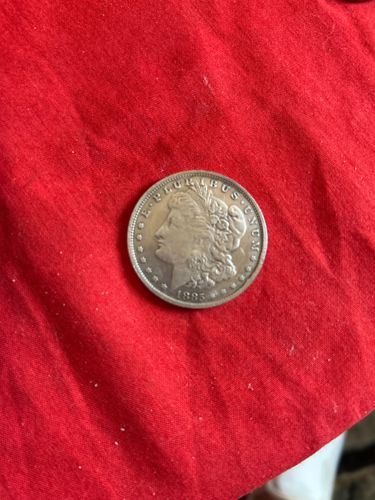Morgan Dollar
Country of Origin: United States
Year of Issue: 1883
Denomination: One Dollar
Composition: 90% Silver, 10% Copper

Brief Description
The obverse of the coin features a left-facing profile of Lady Liberty, often referred to as the 'Morgan head', wearing a Phrygian cap adorned with wheat and cotton, and the word 'LIBERTY' on her headband. The motto 'E PLURIBUS UNUM' is above her head, and the date '1883' is below. The reverse, though not visible in the provided image, typically displays an eagle with outstretched wings clutching arrows and an olive branch, encircled by a wreath, with the inscriptions 'UNITED STATES OF AMERICA' and 'ONE DOLLAR'.
Historical Significance
The Morgan Dollar is one of the most iconic and collected American coins. It was minted from 1878 to 1904, and again in 1921. Its production was authorized by the Bland-Allison Act of 1878, which required the U.S. Treasury to purchase a significant amount of silver and coin it into dollars. This act was a response to the lobbying efforts of mining interests and the deflationary pressures following the demonetization of silver in 1873. The coin is named after its designer, George T. Morgan, a British-born engraver. It played a crucial role in the American economy during the late 19th and early 20th centuries, particularly in the western states, and its design is highly regarded for its artistic merit.
Estimated Value
The estimated value of an 1883 Morgan Dollar can range significantly based on its condition (grade), mint mark (if any, not visible in this image), and specific varieties. In Good (G-4) condition, it might be worth around $30-$40; in Fine (F-12) condition, $40-$60; in Extremely Fine (EF-40), $60-$100; and in uncirculated (MS-60 or higher) condition, values can go from $100 up to several thousands, especially for high-grade or rare mint marks. Without clearer images of both sides and knowledge of its condition, a precise value cannot be given.
Care Instructions
Handle the coin by its edges to avoid transferring oils from your skin, which can damage its surface. Store it in a cool, dry place, ideally in an inert, PVC-free holder or slab designed for coin preservation. Avoid cleaning the coin, as this can significantly decrease its value. Any dust can be gently removed with a soft, lint-free cloth or a non-abrasive brush, without rubbing the surface.
Created At: 2025-08-13T17:29:49.732598